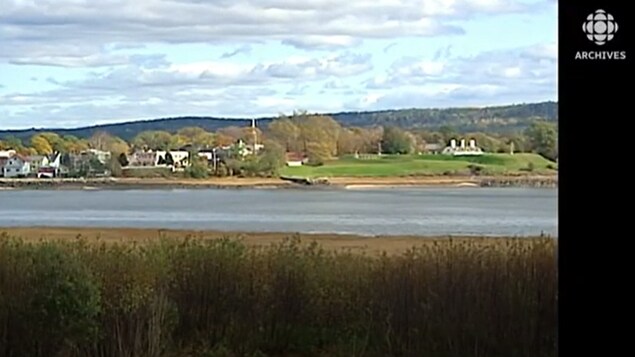Heart of Acadia and Nova Scotia Garden
On March 7, 1976, journalist Gustave Larocque and director André Desbiens present on the show Green week a report on the historical and agricultural aspects of the Annapolis Valley.
Green week, March 7, 1976
—
Gustave Larocque notably interviews Charlie Embree, who is a specialist in fruit growing in the Annapolis Valley.
The valley, a hundred kilometers long and ten kilometers wide, enjoys the protection of two mountain ranges.
These provide it with sunshine and an exceptionally mild climate for this latitude.
This explains why, in the Annapolis Valley, orchards are easily cultivated, including apple trees.
In the 1970s, apple production in the Annapolis Valley was equivalent to half of the individual production of the provinces of Quebec, Ontario and British Columbia.
We grow in the McIntosh Valley and Cortland, but also old varieties like King, Wagner or Gravenstein.
In addition to apples, you can pick plums, pears and blueberries in the Annapolis Valley.
Kings County, located in the Annapolis Valley, was considered the wealthiest rural riding in the Atlantic provinces at the time.
Gustave Larocque also interviews Gordon Leblanc, who reminds us that the Annapolis Valley region is home to the historic and spiritual heart of Acadia.
As early as 1604, the French explorer Samuel de Champlain attempted to colonize this part of North America.
The French subsequently founded Port-Royal (1605), Fort-Anne (1636) and Grand-Pré (1682) there.
The French colonists will develop there an original method of agriculture of dyked lands which exploits the maritime wealth of the environment.
Acadia, which in the Mi’kmaw language means fertile or abundant land, will be the subject of a fierce struggle for conquest between the British and the French until 1710, when the British seize once and for all. of the territory.
Port-Royal was then renamed Annapolis Royal to honor Queen Anne of England.
In 1713, the loss of Acadia by France was confirmed by the Treaty of Utrecht. France retains only what is known today as Cape Breton Island and its fortress of Louisbourg.
In 1755, Great Britain decided to exile the Acadian population which it still considered too attached to France.
It was the Grand Dérangement, which was a disaster for the 10,000 Acadians, especially in Grand-Pré.
These are forced to leave their lands for the French colony of Louisiana, the British American colonies, the West Indies, or even England or France.
The Canadian government recognized Port-Royal as a National Historic Site in 1994.
Recognized places
Parks Canada also preserves another very important place for the memory of the Acadians: Fort-Anne.

Reunion in the land of Evangeline, August 10, 2004
—
This place is the subject of a report by journalist Monique Ferron presented on the show Reunion in the land of Evangeline August 10, 2004.
In 1636, the French built a fort intended to protect the French colony of Port-Royal from the English and the Scots.
Alan Melanson, a guide-interpreter at the Fort-Anne site, recalls that Acadia has suffered the lust of the British and the French for more than a century.
The colony saw 13 battles, making it the most attacked place in Canada.
Fort-Anne will become the seat of government of Acadia.
Nearby is the oldest Acadian cemetery where hundreds of Acadians are buried.
The report also allows us to meet Michel Granger, who is a descendant of Acadians expelled first in England and then in Belle-Île-en-Mer, in Brittany.
This historic heart of Acadia also enjoys international recognition.
In 2012, UNESCO added the Grand-Pré site to its list of World Heritage sites.

Le Téléjournal Atlantique, October 20, 2004
—
Eight years earlier, as recounted in this report by Paul Légère presented at Téléjournal Atlantique on 20 October 2004, UNESCO awarded Annapolis Royal the prize for the city of less than 10,000 inhabitants where the best people live in the world.
It is a recognition that has been accepted with pride by its people.
 –—
–—

